To set up offline voice commands on your sports watch, access the voice settings through your watch interface or companion app, then select your preferred wake-up mode like wrist turn or screen tap. Choose your language for accurate recognition and review available commands that’ll work without internet connectivity. Models like Amazfit GTR series and Garmin fēnix watches offer this functionality once you’ve configured the initial settings. There’s much more to optimize for peak performance.
Understanding Offline Voice Command Technology in Sports Watches

While traditional voice assistants require constant internet connectivity, offline voice command technology in sports watches processes your verbal instructions directly on the device itself.
This local processing eliminates your dependence on internet connections, making it perfect for outdoor activities where cellular coverage might be spotty.
Your watch comes pre-loaded with essential voice commands for common functions like activating sports modes, controlling music playback, and adjusting settings.
Though offline capabilities are more limited than cloud-based assistants, they’re specifically designed for athletic needs. Many sports watches now include AI control features that enhance the offline voice command experience by learning your usage patterns.
This technology conserves your battery life by minimizing data transmission and enhances your privacy since voice data stays on your device rather than being sent to external servers.
Compatible Sports Watch Models and Brand Options
You’ll find several sports watch brands offer robust offline voice command capabilities, with the Amazfit GTR Series leading the pack for budget-conscious users seeking reliable voice control without internet dependency.
Garmin’s voice features provide extensive offline functionality across their fitness-focused lineup, making them ideal for serious athletes who need hands-free operation during intense workouts.
Google’s Pixel Watch rounds out your top options by combining offline voice processing with seamless integration into Google’s ecosystem, though it’s newer to the dedicated sports watch market. The Pixel Watch 3 features voice-to-text response options that work alongside its cutting-edge Actua display for enhanced user interaction.
Amazfit GTR Series
Among the Amazfit GTR series, the GTR 2 and GTR 2e stand out as the primary models supporting offline voice commands with the latest firmware updates.
You’ll find this feature particularly valuable during workouts when your phone isn’t nearby or when signal strength is weak.
To enable offline voice commands, you must set your watch language to English, as it’s currently the only supported language.
Navigate to your watch settings, then User Preferences, and select Offline Voice Control. You can configure the watch to respond after wrist movement or when the screen lights up, with a 5-second response window.
Once activated, you’ll see a “Recognizing offline voice” icon, indicating readiness.
You can then control music playback, start workouts, and manage other features without phone connectivity. Available voice commands include “open heart rate”, “brightness up,” “brightness down,” “open music,” “start playing,” and “volume up” for comprehensive device control.
Garmin Voice Features
Garmin’s voice command ecosystem operates through two distinct systems that serve different purposes on your sports watch.
Voice Command handles watch-specific functions like viewing glances and starting activities, while Phone Assistant manages smartphone interactions including calls and texts. You’ll need to pair your watch with a compatible smartphone through the Garmin Connect app for full functionality.
The fēnix 8 Series and Venu 2 Plus offer the most advanced voice capabilities, though most recent Garmin outdoor and multisport models support voice commands. To discover available options, you can ask “What can I say?” directly to your watch for a list of supported commands.
Your smartphone’s OS and Bluetooth version affect compatibility—older phones may not support all features. While some functions like starting activities work offline, full assistant capabilities require smartphone connectivity for calls, texts, and smart home control.
Google Pixel Watch
Google’s Pixel Watch series brings native Google Assistant integration to sports tracking, offering a more streamlined voice command experience than third-party alternatives.
You’ll find robust compatibility across current models including the Pixel Watch 2 and Pixel Watch 3, both running WearOS 3.5 or newer for enhanced offline capabilities.
The sports-focused features you can access include:
- Fitness tracking with voice control – Set timers, track workouts, and monitor heart rate using hands-free commands during activities.
- Offline map navigation – Access downloaded maps without internet connectivity for trail running or cycling adventures.
- Customizable sports watch faces – Prioritize fitness data display while maintaining quick voice command access.
You’ll activate Assistant by pressing the side button, saying “Hey Google,” or using watch complications, though some features require internet connectivity for full functionality. The watch can connect to gym equipment for direct heart rate monitoring during indoor workouts.
Essential Requirements Before Setting Up Voice Commands
Before diving into voice command setup, you’ll need to verify your sports watch meets specific technical requirements.
First, confirm your watch supports offline voice commands and runs the appropriate OS version, like Wear OS 3.5+ for Google Assistant features. Check that your watch’s microphone is functional and unobstructed while guaranteeing the Bluetooth connection to your paired smartphone remains active.
Verify your watch firmware and related smartphone apps are updated to their latest versions. Your battery should maintain sufficient charge since voice features consume more power.
Review microphone access permissions and voice data processing settings for privacy. Finally, set up in a quiet environment and guarantee your watch’s language settings align with supported voice command languages for prime recognition accuracy. Ensure your smartphone has the correct voice assistant set as default on your device for optimal performance.
Step-by-Step Configuration Process for Amazfit Watches
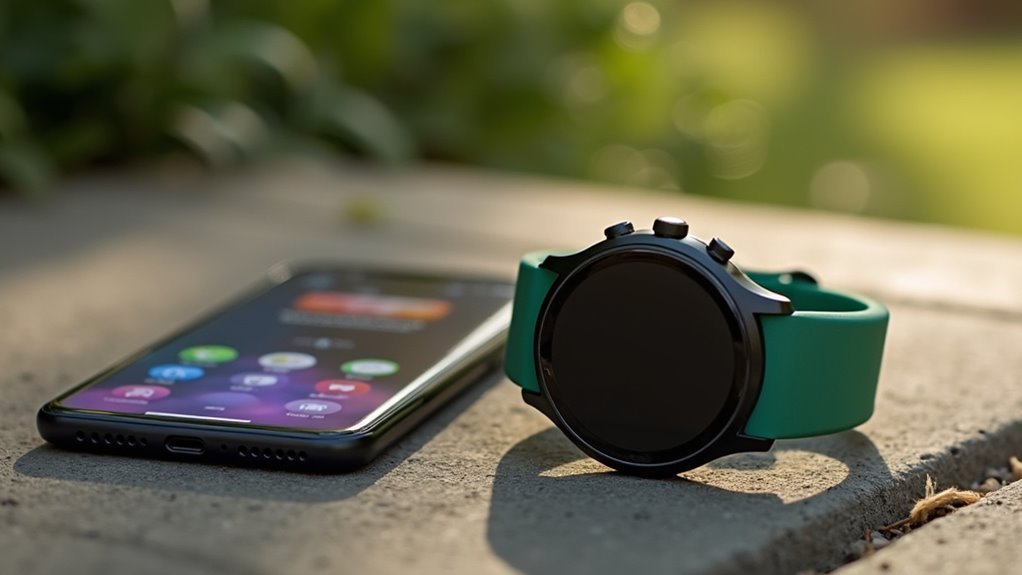
Once your Amazfit watch meets the technical requirements, you’ll need to access the offline voice command settings through either the watch interface or the paired mobile app.
From your watch, tap the crown or side button to access the app menu, navigate to Settings, then select “Preferences” and “Offline Voice Control.” Alternatively, use your Zepp or Amazfit app by going to Profile > Devices > Watch Settings > Offline Voice Control.
Follow these configuration steps:
- Choose your wake-up mode – Select from wrist turn activation, screen lighting response, or continuous listening options.
- Set your preferred language – Pick from available languages like English or Chinese for accurate recognition.
- Review available commands – Access “View All Voice Commands” to learn supported functions and phrases.
For detailed explanations of each wake-up mode option, tap the question mark icon in the settings to better understand how each setting affects when your watch listens for voice commands.
Google Pixel Watch Voice Command Setup Guide
You’ll need to enable “Hey Google” on your Pixel Watch by pressing the side button and following the setup prompts through Google Assistant.
Your watch requires a paired phone and internet connection to access most voice command features, which limits true offline functionality. Make sure your watch is connected to Wi-Fi or mobile data for full functionality during the initial setup process.
While you can use voice control for basic on-watch functions, Google Assistant’s capabilities become considerably restricted without an active internet connection.
Enable Hey Google
Since the Google Pixel Watch integrates seamlessly with Google’s ecosystem, enabling Hey Google voice commands requires completing several essential setup steps before you can start issuing voice commands.
First, access your watch’s Settings menu and navigate to the Google or Assistant section. Verify that Google Assistant is set as your default digital assistant and toggle on “Hey Google” detection. You’ll need to confirm permissions and agree to terms when prompted. During this process, the Google Pixel Watch app will guide you through setting up Google Assistant to ensure proper configuration.
Next, complete the voice activation process:
- Enter the Google Assistant app on your watch and enable “Hey Google” voice activation in Assistant settings
- Complete voice model training by repeating “Hey Google” phrases as the system prompts you
- Test functionality by exiting settings and issuing a voice command to verify everything works properly
Connection Requirements Setup
Before your Google Pixel Watch can respond to voice commands, you’ll need to establish proper connectivity between your watch and paired smartphone. You must maintain an active Bluetooth connection and guarantee both devices remain within ideal range throughout the setup process.
| Connection Element | Requirement |
|---|---|
| Bluetooth Status | Active and stable pairing |
| Device Range | Watch within Bluetooth range of phone |
| Phone Power | Powered on during entire setup |
| Internet Access | Wi-Fi or mobile data on phone |
| Software Updates | Current versions on both devices |
Keep your watch powered on by tapping the screen or pressing the button. Access your phone’s Google Assistant or Google Home app to configure the connection. Grant necessary permissions for microphone access and data sharing when prompted to guarantee seamless voice command functionality. Navigate to the Google Assistant option on your phone to begin the initial setup process for voice control integration.
Voice Command Limitations
While your Google Pixel Watch offers robust voice command capabilities through Google Assistant, several limitations can affect its performance and functionality. You’ll need to understand these constraints to set realistic expectations for your device’s performance.
- Active State Requirements: Your watch must be awake to recognize “Hey Google” or “Ok Google” commands, which can drain battery life and may not respond when the screen is dimmed.
- Intermittent Response Issues: You might experience occasional failures where Google Assistant doesn’t respond to voice commands, with no clear pattern identifying when these problems occur.
- Setup Dependencies: Voice activation requires explicit opt-in during initial setup or manual enablement in settings later, and missing this step prevents hands-free voice command functionality entirely. Certain features like health data queries remain unsupported even when voice commands are properly configured.
Wake-Up Mode Selection and Activation Settings
When you’re setting up offline voice commands on your sports watch, configuring the wake-up mode becomes essential for seamless interaction with your device.
You’ll need to choose your preferred activation method, whether it’s raising your wrist, tapping the display, or pressing buttons. These settings guarantee your watch responds correctly when you want to issue voice commands.
Most sports watches like Garmin and Suunto allow you to access activation settings through their system menus.
You can configure how long the display stays active after waking, preventing interruptions during voice command sequences. For devices that support sleep scheduling, you may need to adjust these settings through the Garmin Connect app depending on your watch model’s compatibility.
Don’t forget to adjust orientation settings based on which wrist you’re wearing the device on, as this affects gesture recognition accuracy for voice command activation.
Customizing Voice Command Responses and Triggers
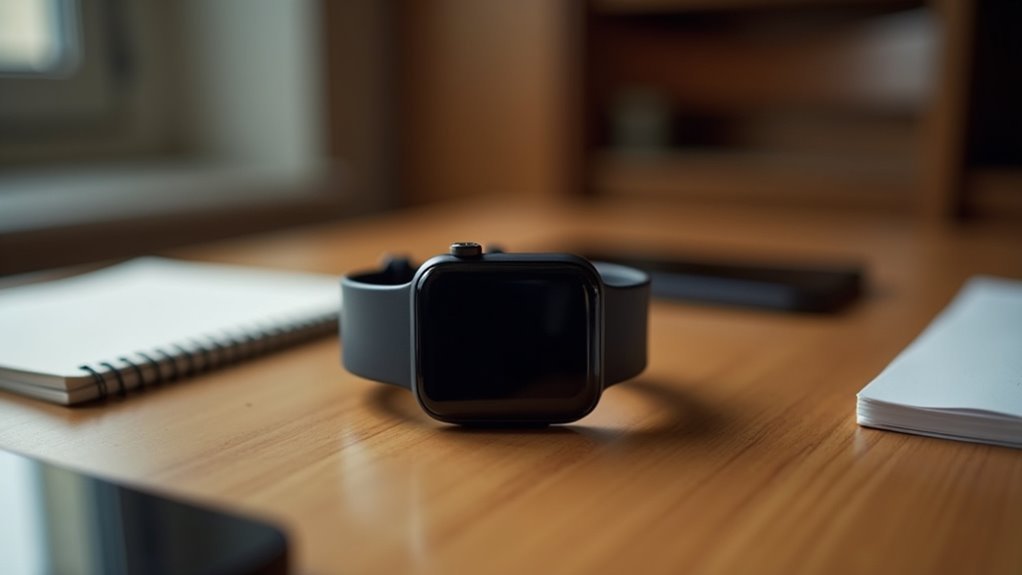
You’ll want to personalize your sports watch’s voice commands beyond the basic wake-up settings.
Custom wake-up phrases let you choose specific words or phrases that activate your watch’s voice recognition, making it more responsive to your preferences.
Response personalization options allow you to adjust how your watch confirms commands and provides feedback, creating a more tailored user experience. Training your device to recognize your specific voice and accent patterns will significantly improve accuracy and reduce misinterpretation of commands during workouts.
Custom Wake-Up Phrases
How can you make your sports watch respond to your unique voice instead of generic wake words? You’ll create custom wake phrases using platforms like Picovoice’s Porcupine engine, which offers up to 3 free wake words monthly. This eliminates false activations common with “Hey Siri” or “Alexa” during workouts.
Your setup involves three key steps:
- Register on Picovoice – Create your account and receive an Access Key to manage wake word limits.
- Design your phrase – Choose 2-3 syllables that work well in noisy sports environments.
- Integrate offline – Deploy to Raspberry Pi or similar hardware that triggers your watch’s voice system.
You’ll need technical skills for hardware integration and custom firmware. While battery consumption increases slightly from always-on listening, you’ll gain privacy and responsiveness without internet dependency. Similar to how morning reports can be enabled or disabled through watch settings, your custom voice commands require initial configuration to establish personalized activation parameters.
Response Personalization Options
A personalized voice assistant transforms your sports watch from a generic device into an intelligent companion that understands your unique preferences and responds accordingly.
You can customize trigger commands to launch specific actions like tracking workouts or sending quick messages to your contacts. Many sports watches integrate with Google Assistant, enabling personalized responses based on your stored data and activity history.
You’ll find customizable voice notes particularly useful for creating context-specific reminders or messages. Set up routine automation to streamline daily activities through simple voice commands.
Add your voice assistant as a watch face complication for instant access to personalized responses. You can also triple-tap the screen to quickly switch between different watch faces that display your voice command shortcuts. However, remember that offline functionality remains limited across most devices, and voice recognition accuracy varies considerably between different sports watch models and brands.
Available Voice Commands for Health and Fitness Tracking
While traditional fitness tracking requires you to stop mid-workout and fumble with tiny watch screens, voice commands transform your sports watch into a hands-free companion that responds instantly to spoken instructions.
You’ll access extensive health and fitness tracking features without breaking your stride or losing focus during intense training sessions.
Your voice-controlled sports watch offers these essential tracking capabilities:
- Real-time heart rate monitoring with customizable zone alerts that notify you when you’re pushing too hard or need to increase intensity
- Activity tracking commands for seamlessly starting, pausing, and stopping running or cycling sessions while maintaining your workout flow
- Post-workout analysis through voice-activated summaries of distance, pace, calories burned, and performance metrics for immediate feedback
The most advanced sports watches now feature on-device processing that eliminates the need for a paired smartphone connection during workouts.
These commands integrate with other fitness metrics, creating a complete hands-free training experience.
App Navigation Using Voice Controls
Beyond basic fitness tracking, voice controls enable seamless navigation through your sports watch’s entire app ecosystem without requiring you to tap, swipe, or scroll through menus during workouts. You can launch apps, switch between functions, and access settings using simple voice commands through integrated assistants like Siri or Google Assistant.
| Voice Command | Function | Watch Compatibility |
|---|---|---|
| “Start RunGo” | Launch navigation app | Apple Watch |
| “Open Strava” | Begin activity tracking | Wear OS devices |
| “Switch to timer” | Access stopwatch features | Most voice-enabled watches |
Your watch’s voice integration depends on its operating system and paired smartphone connection. Apple WatchOS leverages Siri for thorough app control, while Wear OS utilizes Google Assistant. Remember that offline functionality varies by app—some require internet connectivity for voice recognition, while others process commands locally on your device.
When evaluating GPS watches, consider that screen brightness significantly impacts outdoor visibility during voice-activated workouts, especially when confirming commands or viewing app interfaces in bright sunlight conditions.
Battery Optimization Strategies for Voice Command Usage
Voice commands on sports watches offer tremendous convenience, but they can quickly drain your battery if you don’t manage their power consumption effectively.
Smart voice command management is essential for preserving sports watch battery life during extended training sessions and outdoor adventures.
Strategic optimization guarantees you’ll maintain voice functionality without compromising your watch’s endurance during critical activities.
Here are three essential battery optimization strategies:
- Disable always-on voice activation – Turn off wake words and continuous listening features that constantly process ambient sound, instead using dedicated buttons for manual voice activation.
- Leverage power-saving modes – Enable built-in battery saver settings that automatically limit non-essential functions when power drops below 15%, while maintaining core voice command capabilities. Avoid letting the battery drop below 20% for optimal lifespan and consider activating low-power mode proactively to preserve battery health during extended use.
- Minimize feedback consumption – Reduce vibration strength and mute audio confirmations, opting for silent visual responses that consume considerably less power than haptic and sound feedback.
Managing Microphone Access and Privacy Settings
When you configure offline voice commands, you’re fundamentally granting your sports watch microphone access that requires careful privacy management.
Navigate to your device’s Privacy & Security settings to review which apps can access your microphone. You’ll find options for always allowed, allowed only in use, or never allowed permissions.
Regularly audit these permissions, especially after software updates that might reset your preferences. Deny microphone access to apps that don’t require voice features for sports functionality. Remove unused apps entirely to prevent lingering access risks.
Consider using hardware solutions like physical mute buttons when available. Your Apple Watch’s Control Center offers quick toggles through Do Not Disturb or Airplane Mode. Access your device’s Permission Manager to view all microphone permissions in organized categories for streamlined management.
Always restart apps or your device after changing permissions to guarantee changes take effect properly.
Troubleshooting Common Setup Issues
When setting up offline voice commands on your sports watch, you’ll likely encounter three main challenges that can disrupt your experience.
Voice recognition failures often stem from poor microphone positioning or background noise interference. You can temporarily pause voice recognition by saying “Stop listening” to prevent unwanted command interpretation during noisy environments.
Meanwhile, connectivity error messages typically indicate Bluetooth pairing issues between your watch and smartphone.
Battery drain problems frequently occur when enhanced voice command modes remain active continuously, requiring you to balance functionality with power management.
Voice Recognition Failures
Although sports watches offer convenient voice command features, you’ll likely encounter recognition failures that can disrupt your workout routine or daily activities. These issues stem from various factors that affect your watch’s ability to process voice commands accurately.
Common causes of voice recognition failures include:
- Environmental interference – Background noise from traffic, gym equipment, or crowded areas can overwhelm your watch’s microphone and cause command misinterpretation.
- Hardware limitations – Poor microphone quality or physical obstructions like protective cases can greatly reduce recognition accuracy and responsiveness.
- Software-related problems – Outdated firmware, compatibility issues, or system glitches can cause intermittent failures even when speaking clearly.
Low battery levels also impact recognition sensitivity, while improper device orientation may prevent the microphone from capturing your voice effectively during activities. Modern voice command systems are designed to detect natural speech without requiring exact phrases, which can help reduce some recognition issues when the technology is functioning properly.
Connectivity Error Messages
Setting up offline voice commands on your sports watch can trigger various connectivity error messages that’ll frustrate even tech-savvy users.
These errors typically stem from Bluetooth pairing failures between your watch and smartphone, interrupted connections during voice assistant initialization, or incompatible app versions creating connection mismatches.
You’ll also encounter problems when airplane mode disables Bluetooth or when outdated OS versions cause protocol errors.
To resolve these issues, verify Bluetooth’s activated on both devices, restart them to reset connection stacks, and forget then re-pair your watch through smartphone settings.
Check for battery saver modes limiting Bluetooth functionality and disable them during setup. Additionally, update both your watch firmware and companion app regularly, clear app caches if opt-in flows fail, and disable VPNs that might block authentication requests.
Configure the wrist movement activation setting through your watch’s official app to ensure proper voice command triggering without additional connectivity strain.
Battery Drain Problems
Beyond connection troubles, battery drain issues plague sports watch users attempting to configure offline voice commands. Voice assistants consume significant power even without voice activation enabled, rapidly depleting your battery during setup and regular use.
You’ll need to implement strategic power management to maintain functionality while preserving battery life:
- Disable continuous voice monitoring – Turn off always-listening features and activate voice commands manually through button presses instead of wake words.
- Optimize background processes – Close unnecessary apps running simultaneously during voice command configuration and disable unused connectivity features like Bluetooth or WiFi.
- Adjust display settings – Lower screen brightness and disable always-on display modes while setting up voice commands to reduce power consumption.
Monitor your battery percentage closely during initial setup phases. Additionally, frequent notifications from voice command confirmations can accelerate battery depletion, so consider temporarily disabling non-essential alerts during the configuration process.
Maximizing Voice Command Performance Without Internet
When your sports watch operates without internet connectivity, you’ll need to fine-tune several key settings to guarantee voice commands work reliably.
Set offline voice commands to activate only on wrist motion, which reduces false triggers and conserves battery power. Use clear, distinct voice commands since offline engines have limited vocabulary compared to cloud-based systems.
Control your environment by reducing background noise, as this considerably enhances voice input quality for offline recognition. If your watch supports it, regularly calibrate or re-train voice profiles to improve command accuracy.
Streamline the number of recognized offline commands to reduce processing load and increase responsiveness. Configure response time settings, typically around five seconds post-awakening, to optimize both performance and power usage effectively. Verify your device has sufficient RAM specifications as watches with only 512 MB RAM cannot support offline voice recognition functionality.
Advanced Settings for Power Users
Power users who’ve mastered basic offline voice command optimization can access additional functionality through advanced configuration options.
These settings let you fine-tune your watch’s voice recognition system for maximum efficiency during sports activities and daily use.
Here are three key advanced configurations to explore:
- Custom Wake-Up Mode Selection – Configure voice activation triggers to balance responsiveness with battery conservation, choosing between screen-based activation, button-press triggers, or always-on listening modes.
- Language-Specific Command Optimization – Select your primary language setting and understand how regional dialects affect recognition accuracy, ensuring commands work reliably during workouts.
- Power Management Integration – Leverage offline voice control to reduce data usage and extend battery life by minimizing cloud-dependent interactions while maintaining full functionality. When configuring these settings, remember to pause for clarity between multiple voice commands to ensure accurate recognition during intense workout sessions.
Frequently Asked Questions
Can I Use Offline Voice Commands While Swimming or in Water?
You can’t reliably use offline voice commands while swimming. Water obstructs microphones, preventing voice recognition even on waterproof watches. Manufacturers recommend using touch or button controls during water activities instead.
Do Offline Voice Commands Work With Third-Party Fitness Apps?
You’ll find limited offline voice command support with third-party fitness apps. Most sports watches don’t offer full integration, restricting voice controls to native functions rather than extensive third-party app management.
Will Offline Voice Commands Interfere With Bluetooth Headphone Connections?
You’ll experience minimal interference since offline voice commands process locally without using Bluetooth audio channels. However, microphone activation might occasionally cause brief audio dropouts during simultaneous use with headphones.
Can I Backup and Restore My Voice Command Settings?
You can backup and restore your voice command settings through your watch’s companion app or cloud service. Most sports watches automatically include these settings in regular device backups for easy recovery.
Do Voice Commands Work During Phone Calls or Music Playback?
Voice commands don’t work during phone calls to avoid interference, but they’ll control music playback like pausing or skipping tracks. However, background music noise might affect your watch’s voice recognition accuracy.
In Summary
You’ve now mastered setting up offline voice commands on your sports watch. Remember to regularly update your voice model for better accuracy and keep your watch’s storage optimized for smooth performance. Don’t forget to test commands in different environments and adjust sensitivity settings as needed. With proper configuration, you’ll enjoy hands-free control during workouts without relying on internet connectivity. Practice using various commands to maximize your watch’s potential.

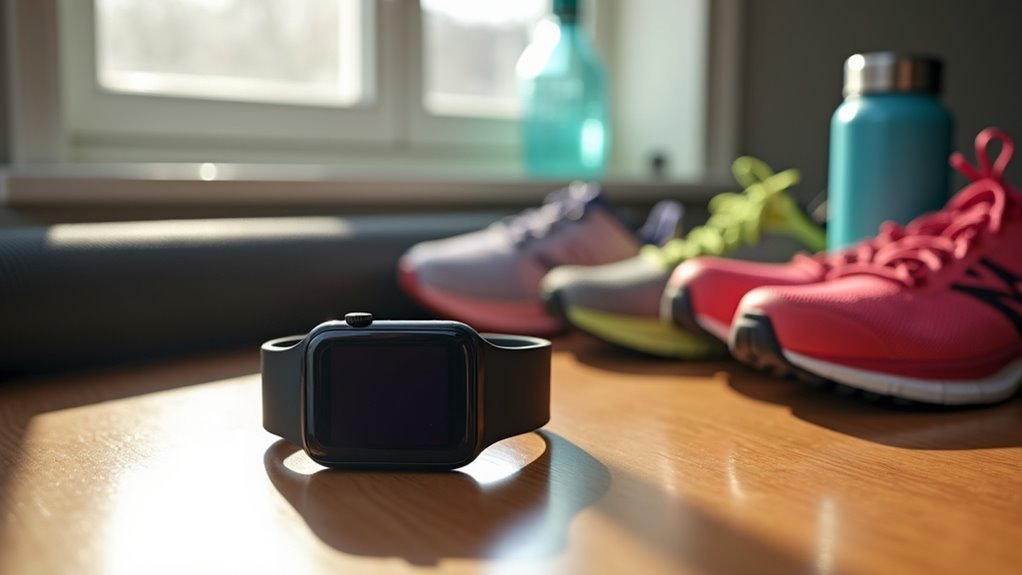
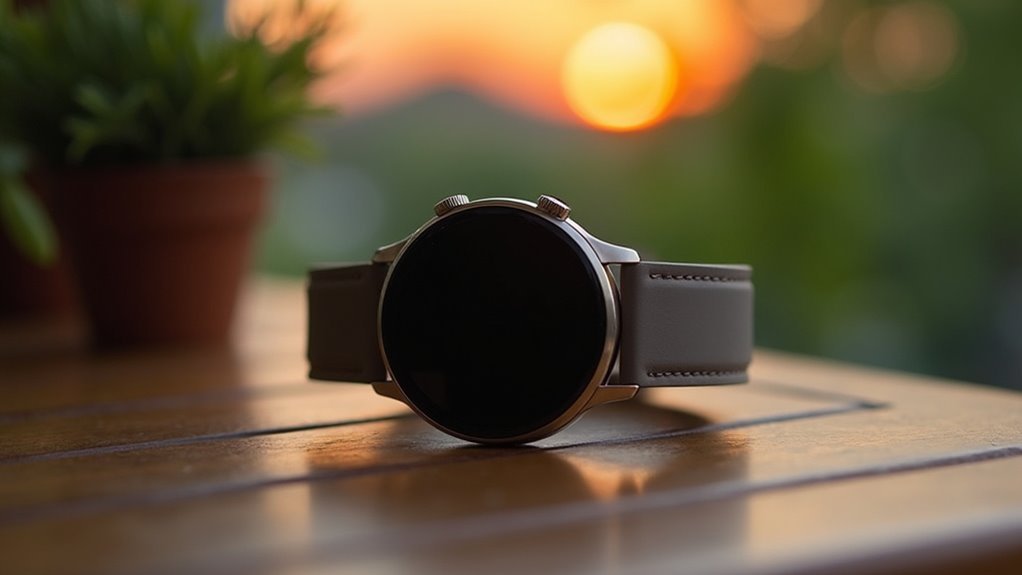
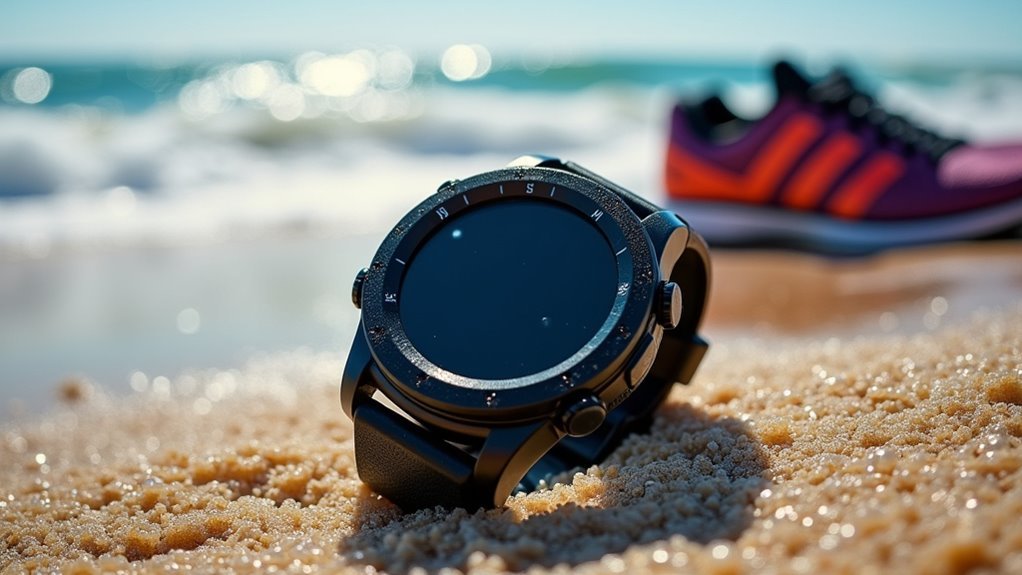
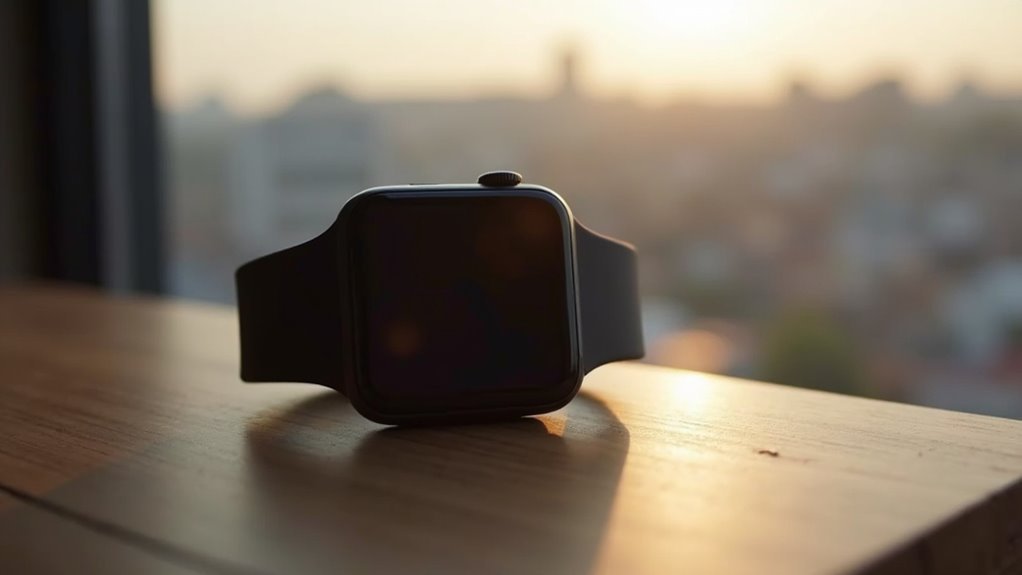
Leave a Reply